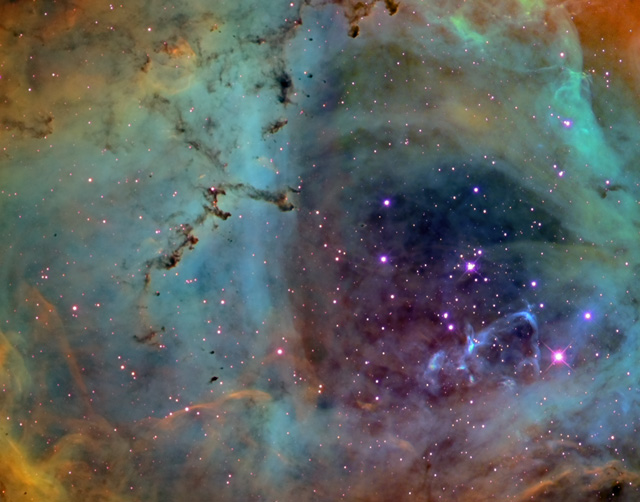
|
Credit & Copyright: Jay Ballauer
(All About Astro,
3RF)
Explanation:
Not all roses are
red of course, but they can still be very pretty.
Likewise, the beautiful
Rosette
Nebula and other star forming regions are often shown in
astronomical images
with a predominately red hue - in part because the dominant
emission in the nebula is
from hydrogen atoms.
Hydrogen's strongest optical
emission line, known as H-alpha,
is in the red region of the spectrum, but the beauty of an
emission nebula need not be appreciated
in red light alone.
Other
atoms in the nebula are also excited by energetic
starlight
and produce narrow emission lines as well.
In this
gorgeous view of the Rosette's central regions,
narrow band images are combined to show
emission from sulfur atoms in red, hydrogen in blue, and
oxygen in green.
In fact, the
scheme of mapping these narrow atomic
emission lines into broader colors is adopted in
many Hubble images
of stellar nurseries.
This image spans about 50 light-years in
the constellation Monoceros, at the 3,000 light-year
estimated
distance of the
Rosette
Nebula.
|
January February March April May June July August September October November December |
| ||||||||||||||||||||||||||||||||||||||||||||||||
NASA Web Site Statements, Warnings, and Disclaimers
NASA Official: Jay Norris. Specific rights apply.
A service of: LHEA at NASA / GSFC
& Michigan Tech. U.
Based on Astronomy Picture
Of the Day
Publications with keywords: NGC 2244 - Rosette Nebula - star formation - emission nebula
Publications with words: NGC 2244 - Rosette Nebula - star formation - emission nebula
See also:
- APOD: 2025 December 28 Á NGC 1898: Globular Cluster in the Large Magellanic Cloud
- NGC 253: Dusty Island Universe
- APOD: 2025 October 21 Á IC 1805: The Heart Nebula
- Young Suns of NGC 7129
- APOD: 2025 December 17 Á W5: The Soul Nebula
- APOD: 2025 December 9 Á The Heart of the Soul Nebula
- APOD: 2025 September 19 Á The NGC 6914 Complex
